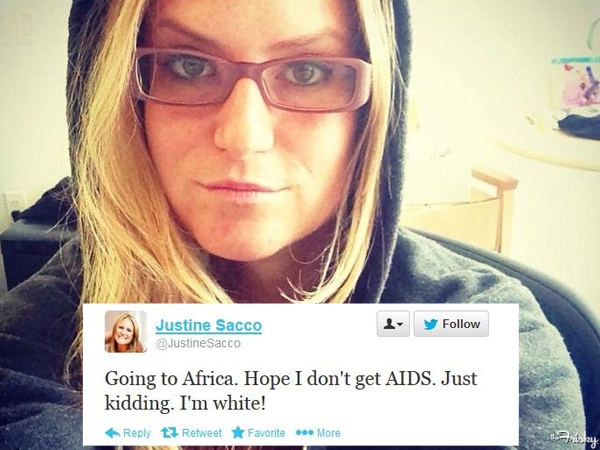
Only on the Internet.
As you probably know by now, on December 20, a PR executive named Justine Sacco became an unlikely news sensation when she tweeted a tasteless remark about AIDs, Africa, and race as she boarded a plane in London for a lengthy British Airways flight to Cape Town, South Africa. When she arrived in Cape Town Saturday morning local time, she discovered that the social media world had exploded with outrage over her single tweet while waiting for her flight to land. News media ranging from Mashable and The New York Times to The Huffington Post had covered the firestorm. She also brought out the good and bad in brands and everyday people.
The Bad
Her inexcusable remark was not the first tasteless tweet she had written, raising the obvious question of how someone in a high-profile PR job could exercise such poor judgment and how her employer, conglomerate IAC, could have overlooked her history of embarrassing Twitter behavior. But she wasn’t the only one behaving badly: in-flight WiFi provider Gogo attempted to turn the news into a real-time marketing opportunity by issuing the following tweet:
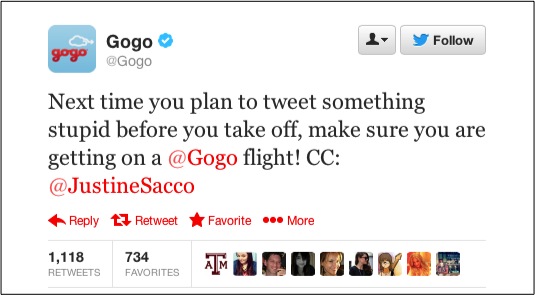
Jason Del Ray of AllThingsD correctly lambasted Gogo for taking real-time marketing to an all-time low. Note to companies: it’s just not a good idea to turn negative news into brand-building opportunities. Common sense, right? Apparently not for Gogo or for a host of other brands who also committed similar missteps in 2013. (Gogo subsequently apologized.)
Also under the “bad” category: Justine Sacco’s Twitter following jumped from 400 to 8,000 as the saga grew. Hers is neither the first nor the last example of someone gaining followers by doing something ugly. Dzhokhar Tsarnaev’s Twitter account grows from 400 to 33,000 followers in the aftermath of the tragedy we now remember as the Boston Marathon bombing. Apparently we cannot help ourselves, sprinting to car wrecks and crime scenes like gawkers in the analog world, willingly following people who spew ugliness into the world.
Oh, and as you might expect: someone created a fake Justine Sacco Twitter account to “apologize” for the incident for no other apparent reason than to inject an element of confusion into the story. Just what we need: another Internet hoax. (The fake account, @justinesacco6, has been deleted.)
The Good
But we also saw flashes of goodness amid the ugly fall-out. Consultant Perry Hewitt (a former colleague of mine) decided to turn the story into an opportunity to generate awareness about AIDS. Recognizing that people were following the Sacco story in real time via the Twitter hashtag #hasJustinelandedyet? — and that Sacco had unwittingly raised awareness for AIDs in Africa — Hewitt implored people to channel their energies into learning more about AIDs and contributing to its eradication.
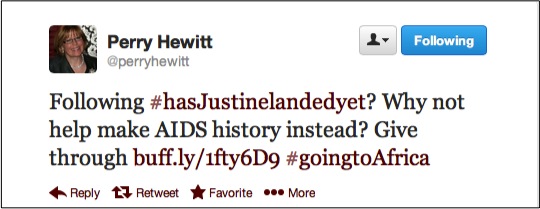
Her tweet contained a link to a site (GoingtoAfrica) that she created overnight to be a clearinghouse for information about how to stop the AIDS epidemic in Africa.
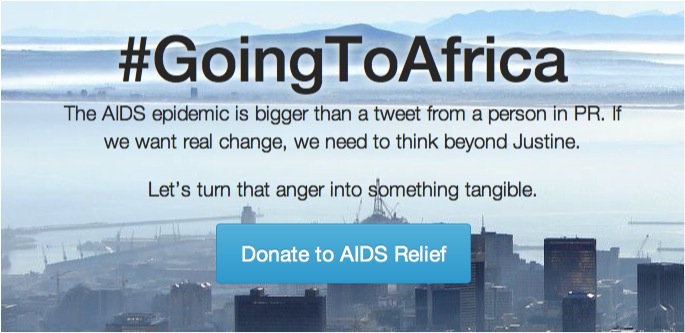
On a similar note, an anonymous party set up a Justinesacco.com URL, which redirects to Aid for Africa, a collective of 85 charities attempting to combat serious problems such as AIDS that remain widespread across the African continent. The redirect turns our gawker behavior on its head and taps into something we also like to do: help — especially when someone makes it easy for us to do so.
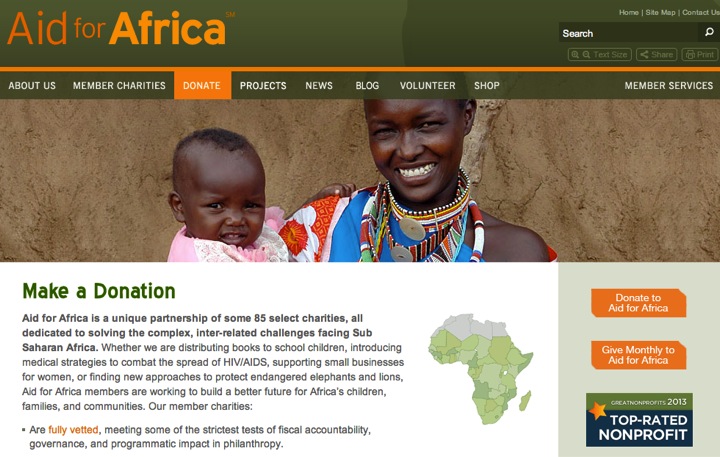
Hijacking an ugly story to generate business for yourself: bad move. Turning negative news into an opportunity to do good: brilliant.

FASHO1LTL
And so it is said, she’s officially fired!